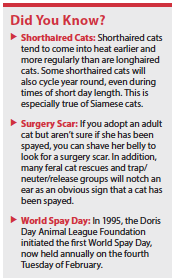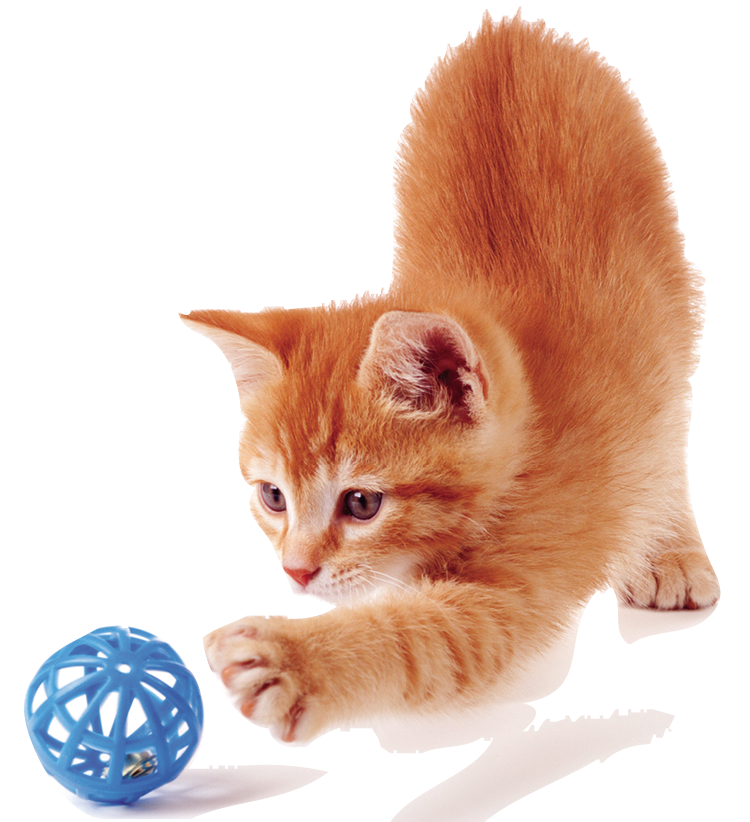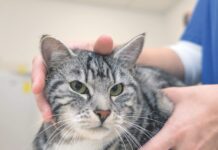Your lovable, sweet kitten is 6 months old and has turned into a menace overnight. Nonstop meowing, pacing, rolling, and biting when you go to touch her are some of the signs you are seeing. If she’s not spayed, she’s probably in estrus (in heat).
Cat heat cycles are influenced by daylight hours, with 12 hours of daylight considered the minimum optimum time. Most kittens will have their first heat right around 6 months of age. The American Association of Feline Practitioners now recommends spaying by 5 months of age to catch most kittens before they have their first heat.
Cats are “seasonally polyestrus.” That means that unless she gets bred (or spayed), your cat will continuously go into heat cycles during her “season.” For cats in North America, that’s about January to October. Not much of a break! March breedings—which research has shown tend to be very fertile—contribute to the huge kitten surplus many rescues and shelters see in June.
Cats are induced ovulators, which means they can become pregnant anytime they are bred. Female cats may mate with multiple males, so a litter often has more than one sire.
 Individual heat cycles vary from cat to cat, but generally last about three weeks. During these three weeks, they will be actively in estrus for about seven days. That means about a week of vocalizing and acting crazy. Then there is a resetting period before it starts all over.
Individual heat cycles vary from cat to cat, but generally last about three weeks. During these three weeks, they will be actively in estrus for about seven days. That means about a week of vocalizing and acting crazy. Then there is a resetting period before it starts all over.
Once bred or, in some cases, spontaneously, a cat will ovulate. In these cases, there is either pregnancy or pseudopregnancy. If she does not ovulate, she will head right back into the estrus cycle.
Behavior Changes
Behavior changes are what most owners notice. Your kitten becomes very affectionate and demanding. She does the rolling behavior and will “tread” with her hind paws on your rugs, furniture, and you. Cats in estrus will often assume a posture with the front end low, the rear end raised, and the tail twitching or slightly turned to the side. Alternatively, the tail may be held out rigidly. They may spray or urinate outside the litterbox, basically announcing their receptiveness to any intact tom cat in the area.
Even with an indoor-only cat, you may see male cats in the area, prowling and spraying outside your house, as your kitten’s pheromone odors are potent. Cats in estrus do not usually have a bloody vaginal discharge like dogs do, and vulvar changes are minimal.
Pregnancy in cats lasts between 63 and 65 days. Since a cat can have up to three litters per year, you can understand why there are concerns about feline overpopulation. Female cats may come into estrus while still nursing kittens.
If left intact, your kitten will have an increased risk for some serious health problems, including pyometra (an infected uterus, which requires an emergency spay) and mammary cancer, which is almost always malignant in cats.
The Spay
Researchers have investigated nonsurgical ways to sterilize cats for some time, thus far without long-term success. Melatonin implants can help suppress estrus in cats, but this is currently a short-term solution. A surgical spay is the only practical option for sterilizing cats at this time.
Cats are commonly spayed even if they are in heat, unlike dogs. As the hormones wane after this procedure, peace will return to your household. When your cat is spayed, her ovaries and uterus are removed, which eliminates the risk of ovarian or uterine cancer. The risk of developing mammary cancer also decreases sevenfold.
Your cat may, however, still show some signs of being in heat or may develop a uterine infection after a spay. This can occur if a small piece of ovarian tissue is left behind after her spay surgery. Pyometras may develop in the uterine “stump” left from a spay.
In some cases, spayed cats may act as if they are in heat if they are exposed to estrogen supplements such as transdermal hormone replacement therapy (HRT) containing estradiol, progesterone, and dehydroepiandrosterone that is being used by their owners. In these cases, cats may lick ointment or oils off of their owner’s skin. In others, cats may be exposed while grooming after cuddling with owners using these supplements.
It is not true that your cat needs to have a heat cycle or a litter of kittens before spaying her. Delaying the spay can expose her to health risks, including injury by a tom cat. Cat matings are often accompanied by growling, shrieking, and possibly fighting. Pregnancy is not without risks. For everyone’s sake, unless you are a cat breeder, spay your kitten.




